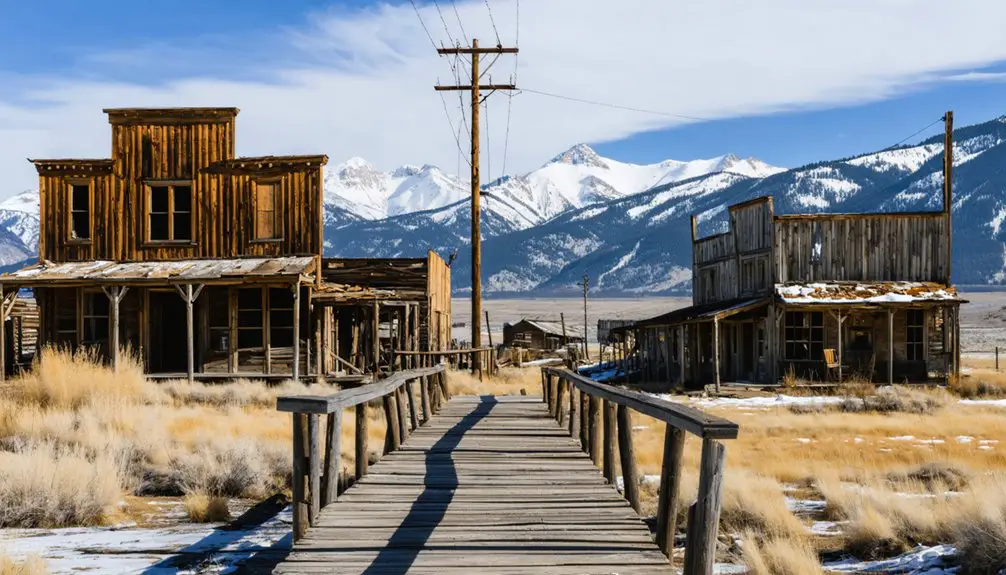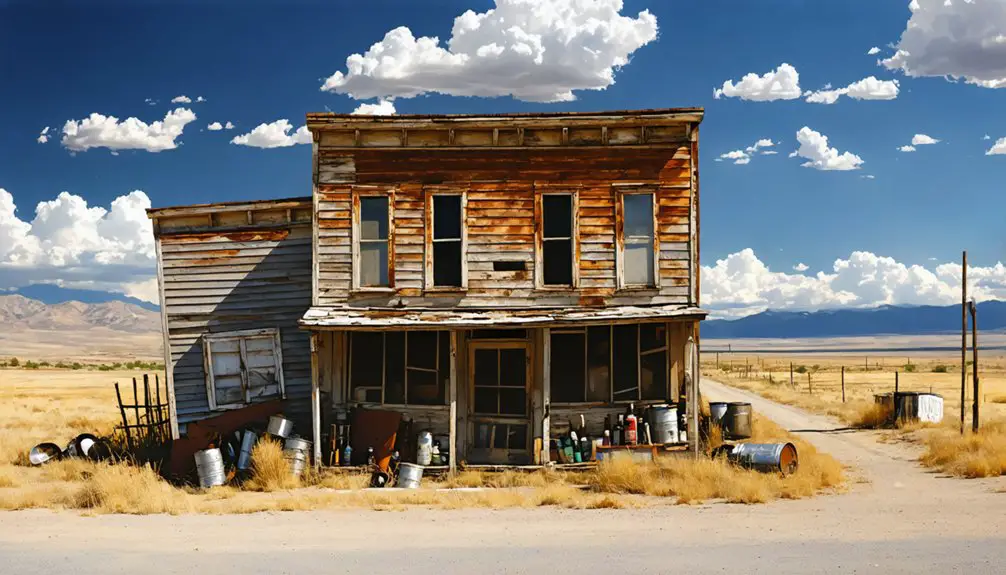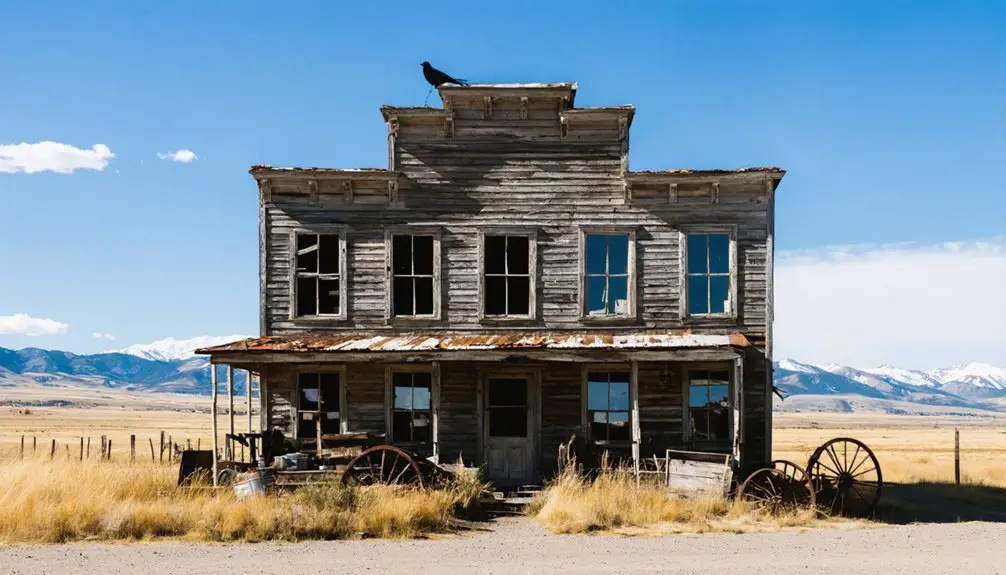You’ll find the ghost town of Pardee nestled at the base of Old Pardee Mountain, where the Rocky Fork Coal Company established its first mine in 1887. The settlement thrived with diverse immigrant workers until the Iron Mountain Mining Company’s closure in 1897 triggered its decline. By the 1930s, only ruins remained of this once-bustling community, which had featured wooden shacks, muddy streets, and a tight-knit population. The site’s rich history holds countless stories of frontier determination and sacrifice.
Key Takeaways
- Pardee was a Montana mining settlement established in 1887 by the Rocky Fork Coal Company, attracting diverse immigrant workers.
- The town declined after Iron Mountain Mining Company’s closure in 1897, with its post office closing in 1921.
- Residents lived in wooden shacks, worked dangerous mining jobs, and formed tight-knit communities despite harsh conditions.
- By the 1930s, Pardee was completely abandoned, with only scattered ruins remaining as evidence of its mining past.
- The site requires 4WD vehicle access from Superior, with no facilities available and visitors needing proper preparation.
The Rise of a Mining Settlement (1887-1900)
While the Crow Nation originally inhabited the area until an 1880 treaty opened it for settlement, Pardee emerged as a significant mining settlement during Montana’s late 19th-century resource boom.
The discovery of rich coal deposits in 1866 sparked interest, but it wasn’t until 1887 when the Rocky Fork Coal Company established the first organized mine that the settlement truly took shape. Similar to the development of Bannack and Virginia City, mining towns throughout Montana became early centers of activity.
Like the workers at the Drumlummon Mine, many miners formed insurance associations to protect themselves and their families.
You’ll find Pardee’s story deeply intertwined with its diverse immigrant workforce, as Finns, Scots, Irish, Italians, and Slavs flocked to the area seeking opportunity.
The settlement grew rapidly, developing housing and basic services to support its expanding population.
Despite frequent mining disputes over resource rights and mineral veins, the community thrived, bolstered by technological advances and the Northern Pacific Railroad‘s demand for coal.
Life Along the Old Pardee Mountain Road
If you’d traveled along Old Pardee Mountain Road in the 1890s, you’d have needed 2.5 days to navigate the challenging five-mile journey by wagon between Pardee’s mines and the Clark Fork River.
Your journey would’ve followed the same moss-lined waterfalls and steep mountain grades that hikers can still explore today along the well-maintained trail. The path traces what was once the Iron Mountain Mining Company’s primary transportation route.
You’d have witnessed the daily bustle of ore wagons, mail carriers fording the river, and supplies moving between mining camps, all part of the essential transportation network that kept Pardee’s community connected to Montana’s broader mining economy. Like the mining camps before it, such as Bear Town which produced an impressive 30 million in gold, Pardee’s success depended on efficient transportation of resources.
Transportation and Mining Logistics
Because Pardee’s mining operations lacked railroad access, the Old Pardee Mountain Road became the lifeline connecting the bustling mining camp to essential supply towns like Missoula and Deer Lodge.
You’d find wagon trains traversing the unpaved routes daily, hauling zinc, lead, silver, and gold-bearing ore to the Iron Mountain Mining Company’s mills while bringing back critical supplies. Similar to the stamp mill operations in nearby Garnet, the processing of ore was essential to extracting valuable minerals. Much like Virginia City’s peak, the area saw thousands of fortune seekers pass through during the height of mining activities.
The mining logistics faced constant transportation challenges. You couldn’t rely on mechanized vehicles – everything depended on animal power and manual labor.
Small carts would move ore from the shafts to surface loading points, where it’d be transferred to wagons for the arduous journey down the mountain.
During winter months, you’d see miners stockpiling supplies, knowing weather conditions could cut off their access to essential provisions and mining equipment.
Daily Wagon Travel Tales
As teamsters guided their heavily-laden wagons along the Old Pardee Mountain Road in the 1890s, a mere five-mile journey from Iron Mountain mine to Clark Fork could stretch into a grueling two-and-a-half-day ordeal.
These wagon anecdotes reveal the harsh realities faced by early settlers like J.K. Wells, who pioneered the shift from pack animals to wagon freight.
You’d find these determined souls fording swift rivers while mail carriers held precious cargo overhead, all while managing draft animals and maintaining their equipment.
Travel hardships included exposure to brutal weather, deep ruts carved in solid rock, and the constant search for water and forage.
Without medical aid or assistance nearby, teamsters relied on their wits and strength, working long hours in isolation to maintain essential supply lines between mining communities and trading hubs like Deer Lodge and Missoula.
Scenic Natural Landscapes Today
While following the well-maintained grade of Old Pardee Mountain Road today, you’ll discover a stunning natural landscape that begins near Cascade Campground off Highway 135.
The trail leads you past moss-covered waterfalls that provide cool relief even during Montana’s dry summers. As you climb higher, you’ll encounter diverse natural habitats within the dense coniferous forests that blanket the mountainside.
The path rises through changing microclimates until you reach scenic vistas along the ridge-line, offering breathtaking views of the Clark Fork River valley below.
During late spring and summer, wildflowers dot the landscape, while year-round moisture pockets near the cascading falls support thick moss growth. These preserved wilderness conditions create perfect spots for rest and nature observation.
Mining Operations and Economic Impact
During the late 19th century, Pardee’s mining operations transformed from simple gold panning into a complex network of placer and lode mining activities.
Mining folklore tells of massive gold deposits up to 50 feet thick, while ghost town legends speak of immigrant miners who struck it rich in the sprawling hydraulic pits and terraces.
You’ll find evidence of W.A. Pardee’s influence through operations like the Algonquin Silver Mine, which helped establish Montana’s reputation as a premier mining region.
The town’s economic impact was substantial, generating millions in gold wealth that fueled local development and attracted waves of entrepreneurs.
While most mining camps lasted 15-20 years, Pardee’s operations continued robustly into the early 1900s, with hydraulic mining persisting until 1918, leaving behind an indelible mark on Montana’s mining heritage.
Challenges of Frontier Infrastructure

You’ll find Pardee’s mountain roads posed constant challenges for miners and supply wagons, with steep grades and narrow passages that became treacherous during Montana’s harsh weather.
The transportation of ore proved especially difficult, as heavy loads had to navigate these precarious routes while avoiding costly damage to both vehicles and valuable cargo.
Teamsters developed specific techniques for managing loaded wagons on the sharp switchbacks, often using multiple horse teams to help control descent speeds and maintain traction on the rough terrain.
Similar challenges faced the Northern Cheyenne Exodus as they traversed Montana’s difficult terrain while fleeing from Fort Robinson in 1879.
Mountain Roads Challenge
As miners flocked to Pardee in the late 19th century, they faced intimidating infrastructure challenges posed by the region’s rugged mountain terrain.
You’d find primitive mountain engineering techniques struggling against steep slopes and unstable soil conditions, while limited machinery meant backbreaking manual labor for road construction and maintenance.
You couldn’t count on consistent access to Pardee, as the dirt and gravel roads fell victim to rockslides, heavy snow, and rain.
When roads became impassable, you’d be cut off from essential supplies, medical care, and communication with the outside world.
The lack of proper guardrails and lighting made travel treacherous, especially for horse-drawn wagons maneuvering narrow mountain passes.
Like other remote mining settlements that became ghost town sites, Pardee’s isolation made it particularly vulnerable to economic downturns.
An aerial tramway system was constructed to help transport ore more efficiently through the challenging terrain.
These harsh conditions ultimately contributed to Pardee’s isolation and eventual decline, as maintaining reliable transportation routes proved an insurmountable challenge.
Ore Transportation Logistics
While early Pardee miners extracted abundant ore from their claims, moving it efficiently from shaft to mill proved a constant struggle against frontier limitations.
You’d find primitive horse-drawn wagons traversing treacherous mountain trails, risking ore contamination and equipment damage with every journey. Without rail connections, the miners couldn’t achieve desired transport efficiency, especially after the Iron Mountain Mining Company’s mill closure in 1897 due to missing emergency exits.
The challenges multiplied when mechanical hoists and elevators failed in the shafts, bringing operations to a halt. Montana’s harsh weather and rugged terrain further complicated matters, while state safety regulations demanded specific tunnel configurations that weren’t always feasible in Pardee’s rough landscape. Similar to Garnet Ghost Town’s location at 6,000 feet above sea level, the high elevation made transportation especially difficult.
These infrastructure constraints ultimately contributed to the town’s decline.
Daily Life in a Montana Mining Town
Life in Montana’s mining towns demanded extraordinary resilience from residents who faced harsh conditions daily. You’d find families crowded into basic wooden shacks, struggling with poor sanitation and muddy streets.
The mining culture revolved around long hours of dangerous work in dusty shafts, where you’d risk cave-ins and frostbite for meager wages that barely covered supplies.
Community resilience showed in how residents supported each other. You could gather at saloons, general stores, and community halls where political discussions and social events strengthened bonds across ethnic lines.
Women kept households running through cooking, nursing, and teaching, while children often worked instead of attending school.
Despite the roughness of daily life, with its gambling and occasional fights, you’d discover tight-knit communities shaped by shared hardships and mutual dependence.
The Decline and Abandonment (1900-1930)

The bustling mining community of Pardee began its steady decline in 1897 when the Iron Mountain Mining Company shuttered its operations. Montana’s mandate for emergency egress tunnels forced the closure, marking the beginning of Pardee’s end.
Once-prosperous Pardee fell silent after Montana’s 1897 tunnel regulations forced the Iron Mountain mine to close its doors.
You’ll find that population migration accelerated after 1900 as mining profitability plummeted and ore veins thinned. Infrastructure deterioration followed swiftly – devastating fires in 1905 destroyed commercial buildings, while the final hotel and assay office burned in 1927.
The post office closed in 1921, and the last saloon shuttered around 1918, eliminating essential community gathering spots.
Unlike other Montana mining towns that experienced brief revivals, Pardee never recovered. By the 1930s, all that remained were scattered ruins and ground depressions where buildings once stood, marking the final chapter of this once-thriving community.
Natural Landmarks and Scenic Features
You’ll discover scenic waterfalls along Pardee’s historic mining trails as Flat Creek tumbles through moss-draped rock formations shaped by decades of flowing water.
The weathered granite outcrops, now covered in thick carpets of emerald moss and lichen, create striking natural sculptures that frame your path through the ghost town site.
From the higher elevations of the old mine workings, you can take in panoramic views of Montana’s rugged ridge lines stretching across the horizon, with forested peaks rising above the creek valley where Pardee once thrived.
Waterfalls Along Historic Trail
Nestled along the Clark Fork River corridor near Pardee, Montana, Cascade Creek Waterfall offers visitors a fascinating natural landmark accessible via Old Pardee Road Trail.
You’ll find two trail options to experience the waterfall ecology: a left fork leading to a marked overlook with bench seating, or a more challenging path to the waterfall’s base starting beyond campsite 8.
For visitor safety, you’ll want to exercise caution on the steeper base trail, which requires some hand support through a cedar grove.
The waterfall’s flow varies dramatically with the seasons – from thunderous spring runoffs to gentler autumn flows.
As you explore, you’ll discover how this natural amphitheater fits perfectly into the surrounding mountain drainage, creating an essential habitat corridor within Montana’s historic mining region.
Moss-Covered Rock Formations
Moving beyond the waterfall’s natural amphitheater, ancient granite and sedimentary rock formations dot Pardee’s landscape, each adorned with vibrant moss layers that transform the ghost town’s rugged terrain.
You’ll find these moss-covered landmarks concentrated near old mining shafts and mill sites, where moisture nurtures their growth and creates essential microhabitats for forest understory species.
The moss ecology here serves multiple purposes: stabilizing soil, protecting against erosion, and providing shelter for small invertebrates.
Near the abandoned buildings, you’ll discover unique rock aesthetics where varying shades of green moss create striking contrasts against weathered stone.
Iron Mountain Mining Company’s excavations inadvertently revealed these natural sculptures, which now stand as protected features under Montana DEQ’s conservation efforts.
Ridge Line Mountain Views
From the highest vantage points along Pardee’s ridge lines, panoramic vistas stretch across the Lolo National Forest region, where Ponderosa Pine and Tamarack trees frame dramatic mountain peaks and winding river valleys.
You’ll discover iconic landmarks like Holland Peak with its distinctive slanted slabs, and the towering Italian Peak reaching nearly 11,000 feet into the wilderness.
The ridge vistas include breathtaking views of the Clark Fork River’s bends and seasonal waterfalls, with strategically placed benches letting you soak in the expansive scenery.
Whether you’re hiking the Old Pardee Road Trail or exploring Flat Creek Road’s rugged terrain, you’ll find well-marked paths leading to spectacular panoramic views.
During winter, snow transforms these overlooks into pristine alpine wonderlands, though many trails become inaccessible.
Accessing the Ghost Town Today
While Pardee’s mountainside location offers a glimpse into Montana’s mining history, reaching this ghost town requires careful planning and proper equipment.
Perched in Montana’s rugged mountains, Pardee ghost town rewards adventurous visitors with authentic mining heritage, but demands thorough preparation and gear.
You’ll need a high-clearance 4WD vehicle to navigate the rough forest roads leading from Superior, about 10 miles south. The rugged terrain and lack of signage make GPS or detailed maps essential for ghost town exploration.
Pack plenty of water, food, and emergency supplies, as there aren’t any facilities on site. Be prepared for rapidly changing weather conditions and spotty cell service.
During winter months, access becomes severely limited, often requiring snowmobiles or skis. When exploring the area, stay alert for old mine shafts and unstable ground.
Remember to check with local BLM offices for current conditions and any necessary permits before your visit.
Legacy of Montana’s Mining Era

As Montana’s mining industry exploded in the 1860s, it fundamentally transformed the territory’s economic and social landscape, laying the groundwork for statehood in 1889.
You’ll find this mining heritage reflected in Montana’s staggering mineral production, which has generated over $150 billion in today’s dollars, with Butte alone accounting for two-thirds of that wealth.
During the industry’s peak, Montana’s mines ranked second nationally in silver production, employing thousands of union workers across bustling communities.
While modern mining has evolved, with about 2,600 workers now in the hard rock sector, you’ll still see potential for economic revival through diverse mineral extraction.
Today’s operations extract palladium, platinum, copper, and gold, carrying forward a legacy that began with those first prospectors who sparked Montana’s transformation from territory to state.
Historical Preservation and Cultural Significance
The preservation of Montana’s ghost towns began taking shape in the 1950s, when communities recognized the urgent need to protect their mining heritage.
You’ll find that early preservation efforts included counties donating historic buildings to the state, as demonstrated by Bannack’s protection starting in 1954.
The Montana Ghost Town Preservation Society, established in 1970, has led the charge in safeguarding these cultural heritage sites.
They’ve worked alongside local museums and preservation groups to purchase and maintain vacant buildings, while also documenting the region’s rich history through newsletters and archives.
Their work’s been bolstered by official recognition, like Bannack’s National Historic Landmark status in 1961.
Today, you can explore these preserved towns through interpretive trails and visitor centers, connecting directly with Montana’s pioneering spirit and mining legacy.
Frequently Asked Questions
Are There Any Documented Deaths or Accidents From the Pardee Mine?
You won’t find documented deaths at the Pardee mine, though safety concerns forced its 1897 closure. While mining accidents were common in Montana, there’s no specific record of Pardee mining accidents.
What Were the Average Wages for Miners Working in Pardee?
While miners worked their fingers to the bone, you’ll find the exact average wages from Pardee aren’t documented. But mining conditions and pay scales mirrored other Montana mines’ modest earnings during that era.
Were There Any Notable Crimes or Lawlessness Reported in Pardee?
You won’t find documented crime reports or notable lawlessness in the town’s history. Local law enforcement wasn’t heavily needed, as the community maintained order until its closure in 1897.
Did Any Famous or Noteworthy Individuals Ever Visit Pardee?
You won’t find records of famous historical visitors or notable residents in this mining town. The site’s documented population consisted mainly of miners, company workers, and local settlers.
What Happened to the Mining Equipment After the Town Was Abandoned?
You’ll find that most mining equipment was removed or scrapped shortly after the 1897 closure, with the rest deteriorating over time. Today, only concrete foundations remain in this ghost town.
References
- https://oldmissoula.com/beartown-history-by-mary-j-pardee/
- https://www.garnetghosttown.org/history.php
- https://www.alpinerunningguides.com/post/old-pardee-road-trail
- https://www.montanaliving.com/blogs/destinations/explore-montana-ghost-towns
- https://www.ghosttowns.com/states/mt/pardee.html
- http://www.miningartifacts.org/MontanaMines.html
- https://archiveswest.orbiscascade.org/ark:/80444/xv28731
- https://archiveswest.orbiscascade.org/ark:80444/xv647063
- https://pubs.usgs.gov/bul/0842/report.pdf
- https://www.blm.gov/sites/default/files/docs/2021-07/THE ROAD TO GARNET’S GOLD (002).pdf



